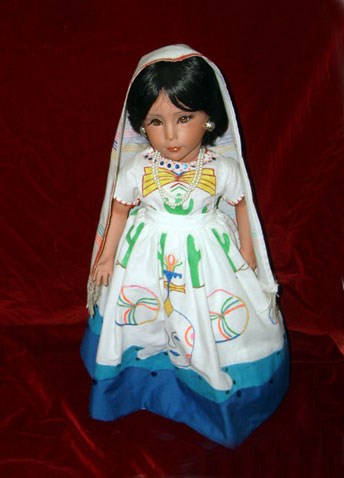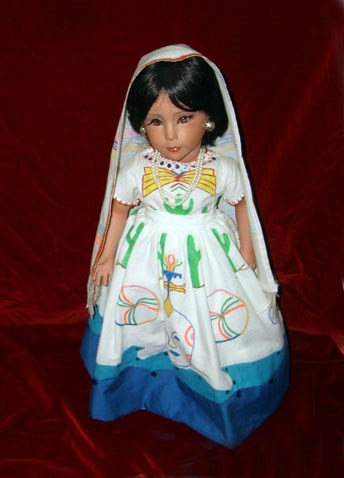
Capital: Mexicali Petra Rosales: "When the territory of Baja California became a state in 1952, the government held a contest to determine the official costume. On September 16, 1954, the design by Maria de la Luz Pulido, was selected." The elements of Baja California are reflected in the multicolored fish, shells, cactus, ad indigenous masks which adorn the blouse and skirt. The peninsula's colors are captured in the turquoise rebozo and the crisp white expanse of skirt that drops into cool blue curves of surf around the hem. With 12 percent of Mexico's total coastline, Baja California enjoys a wealth of fishing, as well as the lucrative industry of salt extraction. What looks like an immense white desert in Guerrero Negro is actually hundreds of shallow tanks filled with seawater evaporating in the hot sun. The salt left behind is purified and processed for use as table salt and in food preservation. (Machaca,salt beef, is a common dish in northern Mexico.) Other uses for salt include smelting and refining, and the manufacture of soap, detergent, fertilizers and insecticides. A mountainous zone runs down the center of the state, and what little rain falls, quickly dissipates in the blazing summer heat. Despite limited fresh water, Mexicali produces an abundance of grains, vegetables and fruit. Aviculture (poultry breeding) is also an important part of the economy. Some 40,000 years ago, people from Asia crossed the Bering Strait to North America. They traveled south, wandered the Baja California peninsula, and eventually reached the highest mountain of the central region. In the caves and protected spots of this rocky terrain, these earliest immigrants held rituals, and commemorated their lives with some of the most beautiful cave paintings in North America. The Kiliwas are indigenous to Baja California; however, they are among the many extremely diverse groups and obscure subgroups that make up Mexico's indigenous population, each with a different language and dialect. Did you know...? 
Capital: Mexicali "Cuando el territorio de Baja California se convirtió en estado en 1952, el gobierno realizó un concurso para elegir el traje oficial. El 16 de septiembre de 1954 quedó seleccionado el diseño realizado por María de la Luz Pulido". Según Petra Rosales Los elementos decorativos del traje de Baja California son: el pez multicolor, las conchas, el cactus y las máscaras indígenas que adornan la blusa y la falda. Los colores de la península se reflejan en el rebozo color turquesa y en la blanca falda almidonada que cae sobre un fresco oleaje azul alrededor del dobladillo. Con el 12% del total de las costas de México, Baja California goza de una lucrativa industria pesquera así como de la extracción de sal. A lo lejos, Guerrero Negro parece ser un inmenso desierto blanco, pero en realidad son cientos de tanques llenos de agua de mar evaporándose bajo el ardiente sol. La sal resultante de la evaporación del agua, se procesa para ser utilizada como sal de mesa, también se usa en la conservación de alimentos, (La machaca, carne seca salada, es un plato común en el norte de México), para la fabricación de jabón, detergente, fertilizantes e insecticidas. Una cadena montañosa corre a lo largo del centro del estado, las escasas lluvias, se evaporan rápidamente bajo el ardiente sol de verano. A pesar de la poca agua dulce, Mexicali produce cantidades abundantes de cereales, frutas y verduras. La avicultura (la cría de aves) es también una parte importante de la economía. Hace aproximadamente 40,000 años, la gente de Asia entró a América por el estrecho de Bering, viajaron hacia el sur, explorando la península de Baja California llegaron a la montaña más alta de la región central. Estos primeros habitantes realizaron rituales en las rocosas cuevas de las montañas, plasmaron sus vidas en las paredes de las mismas, en la actualidad se consideran las pinturas rupestres más hermosas del continente americano. El grupo indígena de Baja California son los Kiliwas y como la mayoría de los grupos indígenas de México, tienen su propio dialecto. Sabías que...? |
Last updated: February 24, 2015
